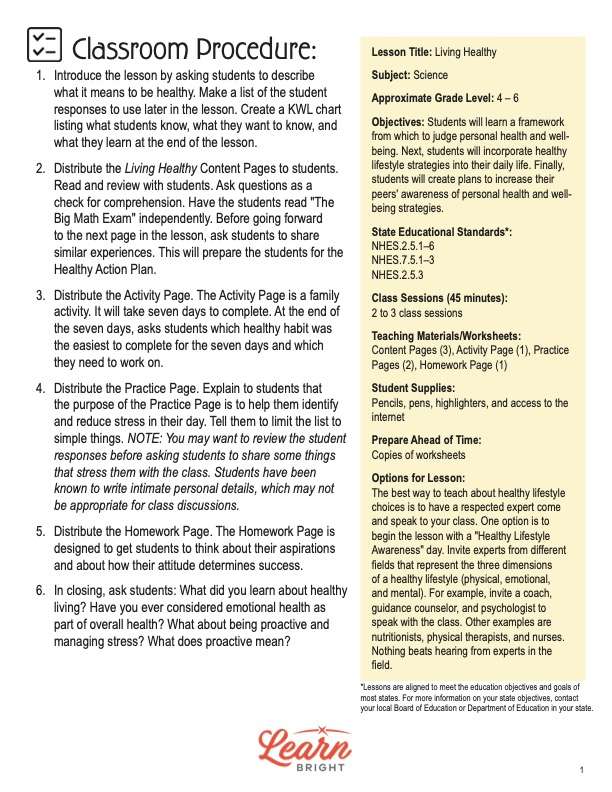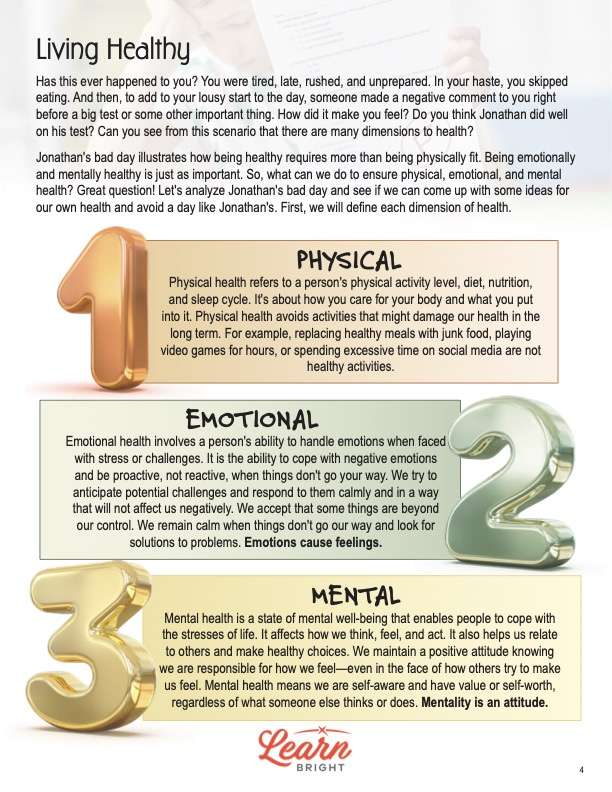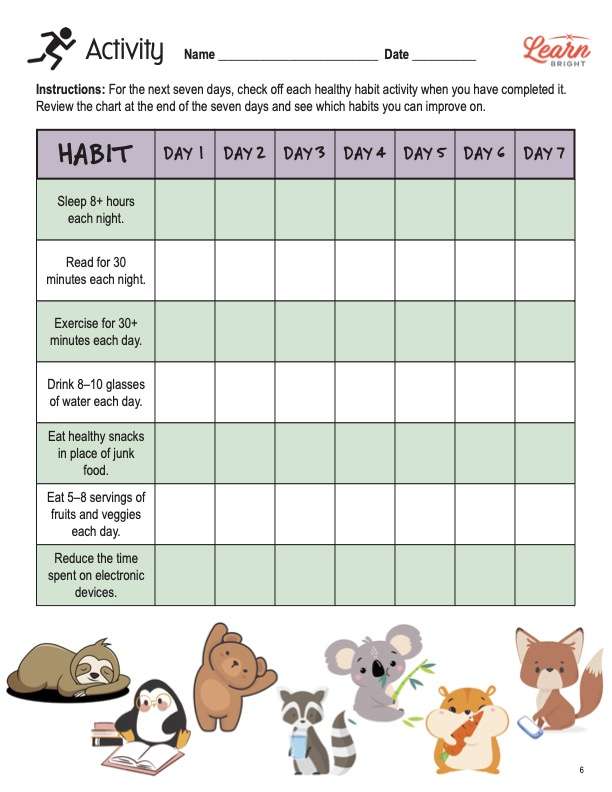Description
What our Living Healthy lesson plan includes
Lesson Objectives and Overview: Living Healthy provides students with a framework from which to judge personal health and well-being. Next, students will incorporate healthy lifestyle strategies into their daily life. Finally, they will create plans to increase their peers’ awareness of personal health and well-being strategies. This lesson is for students in 4th grade, 5th grade, and 6th grade.
Classroom Procedure
Every lesson plan provides you with a classroom procedure page that outlines a step-by-step guide to follow. You do not have to follow the guide exactly. The guide helps you organize the lesson and details when to hand out worksheets. It also lists information in the yellow box that you might find useful. You will find the lesson objectives, state standards, and number of class sessions the lesson should take to complete in this area. In addition, it describes the supplies you will need as well as what and how you need to prepare beforehand. This lesson just requires writing utensils of some kind. Students will also need internet access.
Options for Lesson
In the “Options for Lesson” section of the classroom procedure page, you will find a number of suggestions for ideas and activities to add to the lesson plan. The best way to teach about healthy lifestyle choices is to have a respected expert come and speak to your class. One option is to begin the lesson with a “Healthy Lifestyle Awareness” day. Invite experts from different fields that represent the three dimensions of a healthy lifestyle (physical, emotional, and mental). For example, invite a coach, guidance counselor, and psychologist to speak with the class. Other examples are nutritionists, physical therapists, and nurses. Nothing beats hearing from experts in the field.
Teacher Notes
The teacher notes page provides an extra paragraph of information to help guide the lesson and remind you what to focus on. It explains that this lesson takes a holistic approach to discussing the three dimensions of health. The blank lines on this page are available for you to write out thoughts and ideas you have as you prepare the lesson.
LIVING HEALTHY LESSON PLAN CONTENT PAGES
Living Healthy Introduction
The Living Healthy lesson plan contains three pages of content. When you hear the word healthy, what do you think of? Exercise? Eating well? Being stress-free or rarely ill? These are good descriptions of healthy living, but what does it mean to actually be healthy? The World Health Organization (WHO) defines health as “a state of complete physical, mental, and social well-being and not merely the absence of disease.”
This is not a new idea. Around 400 BCE, the ancient Greeks began thinking about health differently than past civilizations. Before the Greeks, most thought a person’s poor health resulted from punishment from the gods, superstition, or supernatural forces. Then came Hippocrates, a physician and teacher at a medical school on the island of Kos, just off the coast of Greece. Hippocrates believed that all illnesses resulted from natural causes and promoted the idea of holistic health.
What is holistic health? Holistic health is a modern approach to healthy living. Holistic is about body, mind, and spirit. We are much more than a physical body. We must consider our emotional and mental well-being in thinking about our overall health. The lesson then presents a scenario in which a kid named Jonathan is preparing for a math test. It’s an important test that he needs to pass. But lots of things happen the night before and the day of that cause him to fail.
Has this ever happened to you? You were tired, late, rushed, and unprepared. In your haste, you skipped eating. And then, to add to your lousy start to the day, someone made a negative comment to you right before a big test or some other important thing. How did it make you feel? Do you think Jonathan did well on his test? Can you see from this scenario that there are many dimensions to health?
Three Dimensions of Health
Jonathan’s bad day illustrates how being healthy requires more than being physically fit. Being emotionally and mentally healthy is just as important. So, what can we do to ensure physical, emotional, and mental health? Great question! Let’s analyze Jonathan’s bad day and see if we can come up with some ideas for our own health and avoid a day like Jonathan’s. First, we will define each dimension of health.
Physical health refers to a person’s physical activity level, diet, nutrition, and sleep cycle. It’s about how you care for your body and what you put into it. Physical health avoids activities that might damage our health in the long term. For example, replacing healthy meals with junk food, playing video games for hours, or spending excessive time on social media are not healthy activities.
Emotional health involves a person’s ability to handle emotions when faced with stress or challenges. It is the ability to cope with negative emotions and be proactive, not reactive, when things don’t go your way. We try to anticipate potential challenges and respond to them calmly and in a way that will not affect us negatively. We accept that some things are beyond our control. And we remain calm when things don’t go our way and look for solutions to problems. Emotions cause feelings.
Mental health is a state of mental well-being that enables people to cope with the stresses of life. It affects how we think, feel, and act. It also helps us relate to others and make healthy choices. We maintain a positive attitude knowing we are responsible for how we feel—even in the face of how others try to make us feel. Mental health means we are self-aware and have value or self-worth, regardless of what someone else thinks or does. Mentality is an attitude.
Practice
Next, we will analyze Jonathan’s day and create an action plan for what he should have done differently. The lesson provides a chart that lists each health dimension and how Jonathan reacted as it relates to it. Students can write in the final column of the chart what Jonathan could do differently in the future to handle the situation he was in.
While some things are out of your control, such as slow traffic that causes you to be late, you do control how you react to certain situations. That means managing your health is mostly in your control. One trait of healthy people is that they are proactive, or they anticipate problems and think of ways to avoid negative outcomes. Negative comments from other people or events don’t deter proactive people from reaching their goals. Proactive people prepare and expect positive results. Re-read “The Big Math Test.” As you read, think of the dimensions of health. In the space, write what Jonathan can do differently to think proactively instead of reactively.
As you can see, this chart shows several other dimensions of health and wellness. As you get older, more of these will come into play. For example, occupation, job, and career choices impact your life in many ways. But for now, if you can master and balance the three dimensions of health and well-being, you will have an excellent foundation of health! Remember, the key to being healthy is to remain proactive. Ultimately, you are responsible for the healthy decisions you make
LIVING HEALTHY LESSON PLAN WORKSHEETS
The Living Healthy lesson plan includes three worksheets: an activity worksheet, a practice worksheet, and a homework assignment. These worksheets will help students demonstrate what they learned throughout the lesson and reinforce the lesson concepts. The guide on the classroom procedure page outlines when to hand out each worksheet to your students.
HEALTHY HABITS ACTIVITY WORKSHEET
The activity provides students an opportunity to develop some healthy habits for a week. On the worksheet is a table with seven habits. Every day for a week, students will check off each habit if they completed it that day. Then they can review the cart at the end of the week and see which habits they can improve on.
EMOTIONAL HEALTH CHECK-UP PRACTICE WORKSHEET
For the practice worksheet, students will analyze the stressors in their lives and create an action plan for handling that stress. The worksheet explains that everyone experiences stress, but being proactive is the best way to manage it. Students will fill in three things that cause them stress in their day. Then they will write some ways they can be proactive and help prevent that stress. The worksheet provides an example.
LIVING HEALTHY HOMEWORK ASSIGNMENT
Students will write a short essay about how having a positive attitude can help in a situation. They must include a personal experience of when a positive attitude helped them achieve something.
Worksheet Answer Keys
The last page of the lesson document is a sample “answer key” for the practice worksheet. Given the nature of the assignments, students’ responses will vary. This answer key provides sample responses that could help guide students in their thinking when they list their stressors. If you choose to administer the lesson pages to your students via PDF, you can choose to save a new file that omits this page. Or you can simply print out the applicable pages and keep this as reference for yourself. However, you may also choose to allow students to use it for reference, but their answers should not copy the answer key exactly.









